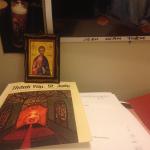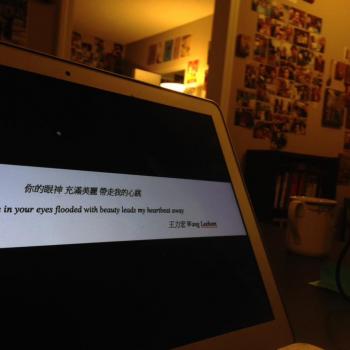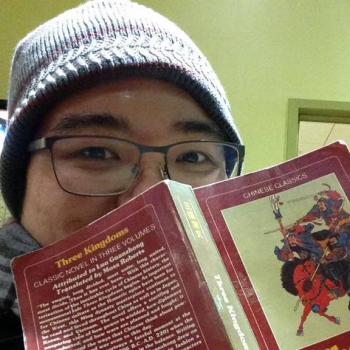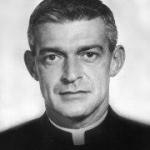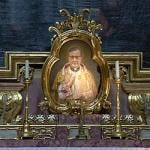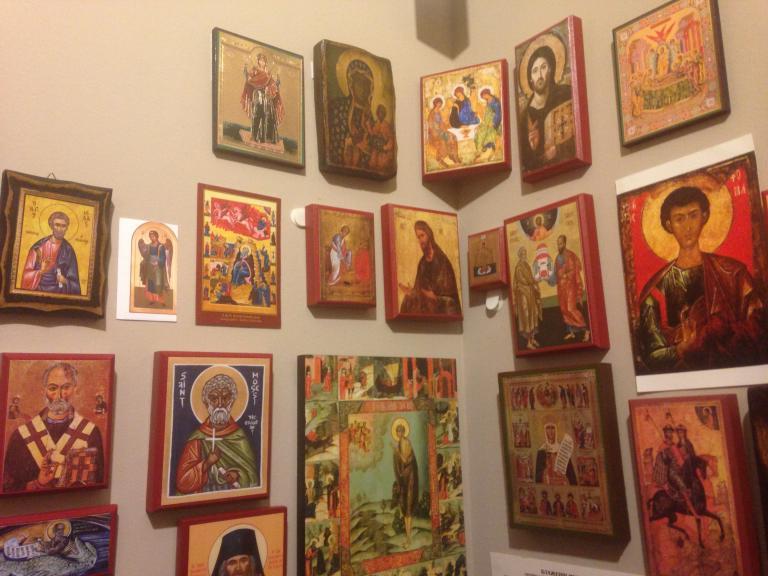
I received a package of icons that I ordered when I was first setting up my icon corner, and in it was a mysterious cardboard print-out that looked iconographic. I had no idea who it was, but I was pretty sure I hadn’t ordered it. I did not know at the time how to search for it on Google Image, so I spent some time looking through icon stores online trying to match name to face. Finally, I found him, and when I did, I felt immediately trolled by divine action. It was Holy Thomas the Apostle.
I do not have a devotion to St Thomas because I am a doubter, though I certainly am that. Of course, I have been thinking about him for a while. In fact, the best sermon that I have ever heard in my life was preached by the Rev Candace Ryals Provey at Duke Chapel on the encounter of Thomas with the risen Lord. But the reason I felt trolled was not because I am always tardy to everything important (like the Resurrection and the Dormition) and doubt things that I miss, though that is also part of my behavioural complex to be sure. It is because of something stupid I’d said in a class on trans-Pacific Christianities when I taught it at the University of Washington.
That day, I had decided that I’d spend the class reiterating that when we talk about trans-Pacific Christianities, we are talking about Western Christian forms like Roman Catholicism and Protestantism even though the locus is in Asia. Eastern Christianities, I said as I was scribbling nonsense of the board, don’t matter in Asia, and I further explained that in a trans-Pacific frame, one would be hard-pressed to talk coherently about communions like Eastern Orthodoxy.
A dear student’s hand shot up. Her family is from Kerala, her mother’s family had background in the Syro-Malankara Church, and her father is canonically Syro-Malabar. She asked whether what I said applied to her family, who could trace their Christian lineage to St Thomas in south India, as they were literally called Thomas Christians. You don’t matter, I said. It was an exaggeration, and that student knew it, and we remain good friends to this day, as do all the participants in that class.
The funniest part, of course, was that not more than nine months afterward, I was an Eastern Catholic catechumen. I wrote to them when that happened, and they revelled in how I had to eat my words. To this day, they will not let me go. The icon of Holy Thomas the Apostle in my beautiful corner is the reminder of me having to eat those words. Every time he sees me and blesses me, I am reminded of the foolishness of my exaggerations, that I had told a Thomas Christian that she didn’t matter and am now in full communion with her. That I received this icon completely out of the blue, probably packed by mistake from the store from which I had ordered other images, is almost a reinforcement that I am experiencing divine trolling. I did not order the icon to be reminded of my folly. Holy Thomas the Apostle came to me without my choosing.
It was the same way with a Latin medal of St Jude that I mysteriously received in the mail not long ago. Of course, I knew who the Holy Apostle Jude was even as an evangelical; his is in competition with the Holy Apostle Paul’s letter to Philemon (whose day it is today) for being the shortest piece in the New Testament. It also competes with the letter to the Hebrews for being the most bizarre (Revelation doesn’t count; it’s off the charts). When we had a small Cantonese evangelical church in Fremont, my mother taught Sunday school for high-schoolers, and for some reason, she mentioned the part of Jude’s letter where he discusses the Holy Archangel Michael rebuking Satan over the body of Moses. I asked her where that was from, devoted as we were to the literal reading of Scripture, and as a class, we could not find it anywhere in the Bible. I even went home and scoured my dad’s copy of the Apocrypha and had no luck. Nobody seems to know what that’s about. There was also a part where Enoch, who was taken up to heaven by God, says something. I did not recall Enoch saying anything in Genesis. It turns out that that’s not even in the Apocrypha. It’s a pseudepigraphal text, as I learned in my New Testament Foundations course at Regent College when I was flirting with ordination. I hear that the Ethiopians consider it canonical, though, and I am usually biased in their favour. Rumour has it that they have Ms Lauryn Hill.
I often use the formulation theology and religious studies to describe what I do with my scholarly work on the supernatural, though I have recently been convinced after years of resisting it that the right word is the postsecular, and I think the Holy Apostle Jude quilts that sensibility together for me. There I was, learning about pseudepigraphal texts at Regent College in preparation for ministry at the seminary (or in Regent’s case, the un-seminary, as they say), and on the other hand, I was well aware from my secular academic work that the lived religion scholar Robert Orsi’s second book is titled Thank You, St Jude.
In terms of religious studies, Orsi is Copernicus. In the good old days when theology and religious studies people thumbed their noses at each other, the modus operandi of religious studies was basically that religion is all about symbols. The anthropologist Clifford Geertz probably said it best in The Interpretation of Culture. Religion for him is about the symbolic order producing moods and motivations that become beliefs, and the study of religion from a secular perspective was to analyze those symbols. Of course, Geertz was not the only game in town — one also thinks of the critique of the secular that runs from Wilfred Cantwell Smith down through Talal Asad and his students, Charles Hirschkind and the late Saba Mahmood — but what Orsi did in the eighties and nineties was basically to say that belief has nothing to do with it all. Practice is what matters. You don’t analyze the symbols; you analyze what people do, and from that performative work, you let your readers in on the world that is being created. In the case, say, of snake handlers in Appalachia, the question is not what the snakes symbolize, but what is the world that is being made as the snakes are being handled. What is important about religion is not what is believed; it’s what is being lived. Orsi’s school of thought, along with the works of Meredith McGuire and Nancy Ammerman and others, became known as lived religion.
Thank You, St Jude is a prime example of this work. Orsi follows the creation of a women’s devotion to St Jude in the south side of Chicago during the Great Depression. The basic observation is that it’s an American Catholic invention, and the spirituality seems to be primarily practiced by women, which means that when men talk about it, they usually talk about St Jude in terms of their mothers and wives (and even ex-wives, in the case studies in the book). As in the Depression, the prayers to St Jude usually focus on ‘hopeless causes,’ things in the world that seem like they can’t be fixed and people that one might as well give up on. Orsi tells the story of himself, not a devotee to St Jude at all, praying once on a plane that was having trouble landing to St Jude. ‘I will still say to the women who asked me that I do not believe in St Jude,’ he writes. ‘But what’s belief got to do with it?’ (p. xxi).
Like my icon of the Holy Apostle Thomas, the medal of St Jude did not come to me of my own choosing. But having received it, I began invoking the prayers of the Holy Apostle Jude in my daily prayers and eventually bought a Greek icon for my icon corner and speak with him every day by his proper name, the Holy Apostle Judas Thaddeus. All of these influences come back to me — my straddling of theology and religious studies, the patron saint of hopeless causes, Orsi’s book — and I sat down to read the letter of Jude once again. It’s remarkable for its contemporary relevance: Jude writes angrily about a way of living within Christianity in the late first century that was nonchalant about sexual practice. Much as I write about chastity, I have been accused of this myself, and I found myself reiterating in my prayers that the praxis of the body is what matters in the world founded on the death and resurrection of Jesus Christ. I later re-read Orsi’s book as a way of reflecting on how the devotion is practiced among American Catholic women mostly in the Latin Church and how it was invented in Chicago.
In so doing, I began reflecting on how I straddle this disciplinary divide between theology and religious studies. Is it not in my own practice of prayer that I put into action my convictions about the postsecular? As I write, I reflect that the icons of the Holy Apostle Thomas and the Holy Apostle Judas Thaddeus remind me to integrate my scholarly work with an ecclesial spirituality rooted in the practice of the body. These are unexpected intellectual connections, mostly because instead of being content with a gap between the ivory tower and the real world, they compel me to bring them together and even to eat my own words when I get carried away. I do not only study religion, then. With fear and trembling, perhaps I do practice theology.
These reflections on the icons in my beautiful corner compose the series I am writing for this year’s St Philip’s Fast in preparation for the Feast of the Nativity, beginning on the Old Calendar as I am in Chicago and switching back to the New Calendar when I return to Richmond in mid-December. They are attempts to account for my process of conversion in the Kyivan Church without discounting the Chinese Christianity of my Protestant past. This post is the eighth.
The previous posts are on the San Damiano Cross, Rublev’s Trinity, the relation of the Black Madonna to the Oranta of Kyiv, the Sinai Pantocrator in relation to the Dormition, the ‘angels and archangels,’ the Prophet Jonah with Moses, Elijah, and John the Baptist, and the Holy Apostles Peter and Paul.


